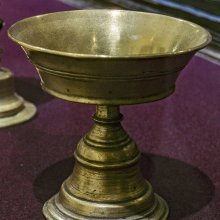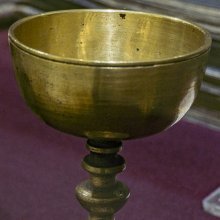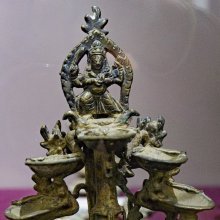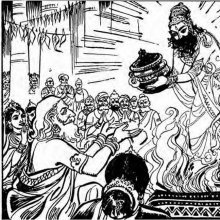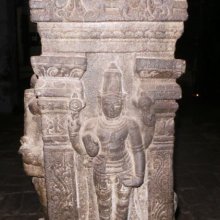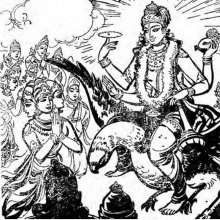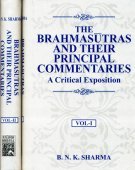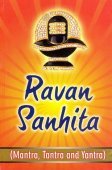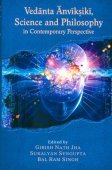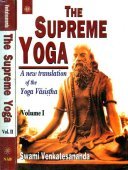Deva, Devā: 52 definitions
Introduction:
Deva means something in Buddhism, Pali, Hinduism, Sanskrit, Jainism, Prakrit, the history of ancient India, Marathi, Hindi, biology. If you want to know the exact meaning, history, etymology or English translation of this term then check out the descriptions on this page. Add your comment or reference to a book if you want to contribute to this summary article.
Images (photo gallery)
(+55 more images available)
In Hinduism
Purana and Itihasa (epic history)
Source: archive.org: Puranic EncyclopediaDeva (देव).—Gods or deities. General information. From time immemorial belief in Devas has existed in every country and all religions have lauded their superior nature and power. It was the Hindus and the Buddhists who first applied the term 'Deva' to certain very subtle beings recognised in all religions. The Pārsi religion (Zaratuṣṭra) has spoken about seven Devarājans and their attendants. 'Ameṣ pentas' is the actual term used for the Devarāja. The Christian religion refers to nine sects of Devas like Srāfi, Kherubi, Dominion, Angel etc. Īslam refers to four chief Devas viz. Gabriel, the presiding Deva over revelations, Mikhayel of protection, Asriyal of death and Israfin of resurruction. An important section of the Ṛgveda is Sūktas about Devās like Indra, Mitra, Varuṇa, Agni etc. In Yajñas etc. Devas occupy a very important place. The Kenopaniṣad states that the conceited and haughty Devas were taught a lesson by God. The subject matter of the Kaṭhopaniṣad is the advice given by Yama to Naciketas. The Muṇḍakopaniṣad says that the Devas, man and birds originated from God.* There are references about Deva worship in the Smṛtis. The Purāṇas and Upapurāṇas contain scientific discussions, about the origin, work or functions, classes, etc. of Devas. The Mantraśāstra and Tantraśāstra deal also about the various sects and class of Devas, their nature, and the worship to be offered to them etc. (See full article at Story of Deva from the Puranic encyclopaedia by Vettam Mani)
Source: Cologne Digital Sanskrit Dictionaries: The Purana Index1a) Deva (देव).—The name of the 6th Kalpa.*
- * Matsya-purāṇa 290. 4.
1b) With fourteen faces; born from the fourfaced Brahmā with different colours and sounds; from these were born 14 Manus.*
- * Vāyu-purāṇa 26. 27-30. Viṣṇu-purāṇa I. 5. 33-4.
1c) One of Viśvāmitra's sons.*
- * Vāyu-purāṇa 91. 96.
1d) A son of Akrūra and Ugrasenī.*
- * Vāyu-purāṇa 96. 112.
1e) A son of Devaka.*
- * Vāyu-purāṇa 96. 129.
1f) Eight kinds of Gods.*
- * Vāyu-purāṇa 58. 123.
Deva (देव) is a name mentioned in the Mahābhārata (cf. I.59.7, I.65, I.61.1) and represents one of the many proper names used for people and places. Note: The Mahābhārata (mentioning Deva) is a Sanskrit epic poem consisting of 100,000 ślokas (metrical verses) and is over 2000 years old.

The Purana (पुराण, purāṇas) refers to Sanskrit literature preserving ancient India’s vast cultural history, including historical legends, religious ceremonies, various arts and sciences. The eighteen mahapuranas total over 400,000 shlokas (metrical couplets) and date to at least several centuries BCE.
Natyashastra (theatrics and dramaturgy)
Source: Wisdom Library: Nāṭya-śāstra1) Deva (देव, “lord”) refers to a specific “mode of address” (nāman) used in drama (nāṭya), according to Nāṭyaśāstra chapter 19. Deva is used by servants to address their king.
2) Deva (देव) refers to a women of goddess (deva) type, according to Nāṭyaśāstra chapter 24.—“A woman who has delicate limbs, steady and soft looks from the corner of her eyes, is free from any disease, has lustre, munificence, truth and simplicity, emits very little sweat, has middling sexual passion, takes moderate food, loves sweet scent and is engaged in vocal and instrumental music, is known to possess the nature of a goddess (deva)”.
3) Deva (देव) refers to the “gods” according to the Nāṭyaśāstra chapter 35. Accordingly, the role (bhūmikā) of actors playing the Gods is defined as, “Persons who have all the limbs intact, well-formed and thick-set, who are full-grown, not fat or lean or tall or large, who have vivacity, pleasant voice and good appearance, should be employed to take up the role of gods (deva)”.

Natyashastra (नाट्यशास्त्र, nāṭyaśāstra) refers to both the ancient Indian tradition (shastra) of performing arts, (natya—theatrics, drama, dance, music), as well as the name of a Sanskrit work dealing with these subjects. It also teaches the rules for composing Dramatic plays (nataka), construction and performance of Theater, and Poetic works (kavya).
Vastushastra (architecture)
Source: Wisdom Library: Vāstu-śāstraDeva (देव, “gods”) refers to one of the three gaṇa (clusters), according to the Mānasāra. Gaṇa is one of the three alternative principles, besides the six āyādiṣaḍvarga, used to constitute the “horoscope” of an architectural or iconographic object. Their application is intended to “verify” the measurements of the architectural and iconographic object against the dictates of astrology that lay out the conditions of auspiciousness.
The particular gaṇa (e.g., deva) of all architectural and iconographic objects (settlement, building, image) must be calculated and ascertained. This process is based on the principle of the remainder. An arithmetical formula to be used in each case is stipulated, which engages one of the basic dimensions of the object (breadth, length, or perimeter/circumference). Of the three gaṇas, the asura (demonic) and manuṣa (human) class are to be avoided.

Vastushastra (वास्तुशास्त्र, vāstuśāstra) refers to the ancient Indian science (shastra) of architecture (vastu), dealing with topics such architecture, sculpture, town-building, fort building and various other constructions. Vastu also deals with the philosophy of the architectural relation with the cosmic universe.
Vaishnavism (Vaishava dharma)
Source: Pure Bhakti: Bhagavad-gita (4th edition)Deva (देव) refers to “demigods”. (cf. Glossary page from Śrīmad-Bhagavad-Gītā).

Vaishnava (वैष्णव, vaiṣṇava) or vaishnavism (vaiṣṇavism) represents a tradition of Hinduism worshipping Vishnu as the supreme Lord. Similar to the Shaktism and Shaivism traditions, Vaishnavism also developed as an individual movement, famous for its exposition of the dashavatara (‘ten avatars of Vishnu’).
Ganitashastra (Mathematics and Algebra)
Source: archive.org: Hindu MathematicsDeva (देव) represents the number 33 (thirty-three) in the “word-numeral system” (bhūtasaṃkhyā), which was used in Sanskrit texts dealing with astronomy, mathematics, metrics, as well as in the dates of inscriptions and manuscripts in ancient Indian literature.—A system of expressing numbers by means of words arranged as in the place-value notation was developed and perfected in India in the early centuries of the Christian era. In this system the numerals [e.g., 33—deva] are expressed by names of things, beings or concepts, which, naturally or in accordance with the teaching of the Śāstras, connote numbers.

Ganitashastra (शिल्पशास्त्र, gaṇitaśāstra) refers to the ancient Indian science of mathematics, algebra, number theory, arithmetic, etc. Closely allied with astronomy, both were commonly taught and studied in universities, even since the 1st millennium BCE. Ganita-shastra also includes ritualistic math-books such as the Shulba-sutras.
General definition (in Hinduism)
Source: Google Books: Genealogy of the South Indian DeitiesDevas are gods who are placed in the world known as Devaloka. In this world [of human beings] they do not have either temples or adoration, with an exception that they are remembered in several ways in the history books [i.e., in Purāṇas]. Whenever sacrifices are offered to the above-mentioned gods and goddesses, the Devas receive some attention [lit. ceremonies] too.
There are many beings that do not have the name of a god. Since they are highly respected, they are mentioned in the history books [i.e., Purāṇas]. They too must be counted to the number of Devas.
Source: Google Books: Genealogy of the South Indian DeitiesThe whole Genealogy of the South Indian Deteis is divided into four main parts:
- Parāparavastu;
- Mummūrttis;
- Grāmadevatās;
- Devas.
Deva (देव): The Sanskrit word for god or deity. It can be interpreted as a demi-god, deity or any supernatural being of high excellence.
In Buddhism
Theravada (major branch of Buddhism)
Source: Access to Insight: A Glossary of Pali and Buddhist TermsLiterally, "shining one" - an inhabitant of the heavenly realms (see sagga and sugati).Source: Pali Kanon: Pali Proper Names1. Deva - Aggasavaka of Sujata Buddha. He was a chaplains son, and the Buddhas first sermon was addressed to him and his friend Sudassana (J.i.38; BuA.168, 170). He is also called Sudeva (Bu.xiii.25).
2. Deva - A devaputta, son of Virupakkha and brother of Kalakanni (J.iii.261).
3. Deva - A monk, resident in Kappukagama (v.l. Kambugama). Voharikatissa heard him preach and restored for him five buildings (Mhv.xxxvi.29; Dpv.xxii.41).
This may be the Thera whom Sanghatissa heard preaching the Andhakavinda Sutta. The king, being very pleased with him, set up an offering of gruel to the monks of the Mahavihara (Dpv.xxii 50).
4. Deva - A thera of Ceylon at whose request Upasena wrote the Maha Niddesa Commentary (MNidA.i.1).
5. Deva - See also Maliya(Malaya-)-deva and Mahadeva.
6. Deva - A Thera of Ceylon, who, according to the Gandhavamsa (Gv. p.63), wrote the Sumanakutavannana. This work is, however, generally ascribed to Vedeha (P.L.C.223f; Svd.1263).
7. Deva - Senapati of Kittisirimegha. He was stationed at Badalatthali, and accompanied Ratnavali when he took the young Parakkamabahu to Kittisirimegha. Cv.xxvii.82.
8. Deva - Lankadhinayaka. A general of Gajabahu II. Cv.lxx.104, 324.
9. Deva - A general of Parakkamabahu I. He took part in the campaigns against Gajabahu, and later was sent to his rescue in Pulatthipura. Deva was imprisoned there, and Parakkamabahu sent housebreakers to release him, after which he was despatched with an army to Gangatataka, where he defeated Manabharana. At Hedillakhandagama he defeated Mahinda. The last we hear of him is that he fell into his enemys power at a village called Surulla. Parakkamabahu went to rescue him, but had to abandon the effort. It is possible that he was ransomed and became Lankapura. (See below.) Cv.lxx.123, 153-7, 245, 285, 300, 316; lxxii.45, 75, 82, 122, 137f.
10. Deva - A general of Parakkamabahu I., called Lankapura, probably identical with 9. He fought against Sukarabhatu, and later took part in the Sinhalese expedition to South India and fought in fierce battles at Tirippaluru and Rajina, capturing the latter place. Cv.lxxv.130; lxxvi.250, 310, 324, 326.
11. Deva - A minister of Ayasmanta. He was sent to erect a vihara at Valligama. Cv.lxxx.38.
12. Deva - A setthi of Vedisagiri. His daughter Devi was married to Asoka, who met her while staying at her fathers house on his way to Ujjeni. MT.324; Sp.i.70.
13. Deva. A minister of Devagama. He once gave food to a starving dog. He was reborn in the same village, and later entered the Order at Pupphavasa Vihara. During the Brahmanatiya famine a tree deity looked after him for twelve years. Once men looking for food wished to kill him, but he was saved by his luck. He became an arahant,
-- or --
1. Deva - A class of beings.Source: Dhamma Dana: Pali English Glossary
M Being dwelling in the sphere of existence bearing the same name and which is superior to the one of humans.
A deva is endowed with far subtler and more refined sensuous perceptive faculties than the ones of humans. There do exist six different categories of devas. The individuals pertaining to the lowest category can expect to live up to nine millions of years and the ones pertaining to the loftiest, up to nine billions two hundred sixteen millions of years. A deva does enjoy a tremendous comfort. All his needs are being fulfilled in such an easy way that he absolutely has no effort to do to satisfy them.
Most of humans dream to experience these kinds of living conditions as they ceaselessly go after pleasure. Such a rejoicing life quality as the one of a deva is dangerous as in no wise does it stir up within those beings (except a few exceptional cases) an interest into the path to detachment, which is meant for eradicating suffering. In spite of the appearances, suffering is being experienced, at any elapsing moment, among all the beings of each sphere of existence. Thus, the kind of life which is led by a deva widely prompts him to be rooted into ignorance.
Source: Pali Kanon: Manual of Buddhist Terms and Doctrines(lit: the Radiant Ones; related to Lat. deus): heavenly beings, deities, celestials, are beings who live in happy worlds, and who, as a rule, are invisible to the human eye.
They are subject, however, just like all human and other beings, to ever-repeated rebirth, old age and death, and thus are not freed from the cycle of existence and from misery. There are many classes of heavenly beings.
I. The 6 classes of heavenly beings of the sensuous sphere (kāmāvacara or kāma-loka; s. avacara loka), are
- Cātumahārājika-deva,
- Tāvatimsa,
- Yāma,
- Tusita (s. Bodhisatta),
- Nimmāna-rati,
- Paranimmita-vasavatti. Cf. anussati. (6).
II. The heavenly beings of the fine-material sphere (rūpāvacara or rūpaloka) are:
- Brahma-pārisajja, Brahma-purohita, Mahā-brahmāno (s. brahma-kāyika-deva). Amongst these 3 classes will be reborn those with a weak, medium or full experience of the 1st absorption (jhāna, q.v.).
- Parittābha, Appamānābha, ābhassara. Here will be reborn those with experience of the 2nd absorption.
- Paritta-subha, Appamāna-subha, Subha-kinna (or kinha). Here will be reborn those with experience of the 3rd absorption.
- Vehapphala, Asañña-satta (q.v.), Suddhāvāsa (q.v.; further s. Anāgāmi). Amongst the first 2 classes will be reborn those with experience of the 4th absorption, but amongst the 3rd class only Anāgāmis (q.v.).
III. The 4 grades of heavenly beings of the immaterial sphere (arūpāvacara or arūpa-loka) are:
- the heavenly beings of the sphere of unbounded space (ākāsānañcāyatanūpaga-devā),
- of unbounded consciousness (viññānañcāyatanūpaga-deva),
- of nothingness (ākiñcaññāyatanūpaga devā),
- of neither-perception-nor- non-perception (nevasaññā-nāsaññāyatanūpaga-devā). Here will be reborn those with experience of the 4 immaterial spheres (arūpāyatana; s. jhāna 5-8).
See Gods and the Universe by Francis Story (WHEEL 180/181).
Theravāda is a major branch of Buddhism having the the Pali canon (tipitaka) as their canonical literature, which includes the vinaya-pitaka (monastic rules), the sutta-pitaka (Buddhist sermons) and the abhidhamma-pitaka (philosophy and psychology).
Mahayana (major branch of Buddhism)
Source: Wisdom Library: Maha Prajnaparamita SastraDeva (देव).—There are three kinds of gods (deva):
- the metaphorical gods (saṃmatideva),
- the gods by birth (upapattideva),
- the pure gods (viśuddhideva).
The Cakravartin kings and other Mahārājas are called saṃmatideva. The gods of the Caturmahārajakāyika heaven up to those of the Bhavāgra are called upapattideva. The Buddhas, the Dharmakāya Bodhisattvas, the Pratyekabuddhas and the Arhats are called viśuddhideva.
Source: academia.edu: A Study and Translation of the GaganagañjaparipṛcchāDeva (देव) refers to the “Gods”, according to the Gaganagañjaparipṛcchā: the eighth chapter of the Mahāsaṃnipāta (a collection of Mahāyāna Buddhist Sūtras).—Accordingly, “What then, son of good family, is the recollection of gods (devānusmṛti), which is authorized by the Lord for Bodhisattvas? It is the recollection of two assemblies of gods (deva-nikāya). What are these two? The gods of the Pure Abode, and the Bodhisattvas hindered by only one birth, who dwell in the Tuṣita Heaven. In that the Bodhisattva recollects the gods of the Pure Abode. Further, the Bodhisattvas who are hindered by only one birth, and who dwell in the Tuṣita Heaven recollect ten qualities as the summit. What are those ten qualities?”

Mahayana (महायान, mahāyāna) is a major branch of Buddhism focusing on the path of a Bodhisattva (spiritual aspirants/ enlightened beings). Extant literature is vast and primarely composed in the Sanskrit language. There are many sūtras of which some of the earliest are the various Prajñāpāramitā sūtras.
Tibetan Buddhism (Vajrayana or tantric Buddhism)
Source: Wisdom Library: Tibetan Buddhism1) Deva (देव) refers to a group of deities summoned by the Yamāntaka-mantra and mentioned as attending the teachings in the 6th century Mañjuśrīmūlakalpa: one of the largest Kriyā Tantras devoted to Mañjuśrī (the Bodhisattva of wisdom) representing an encyclopedia of knowledge primarily concerned with ritualistic elements in Buddhism. The teachings in this text originate from Mañjuśrī and were taught to and by Buddha Śākyamuni in the presence of a large audience (including Deva).
2) Deva (देव) is also the name of a Rāśi (zodiac sign) mentioned as attending the teachings in the 6th century Mañjuśrīmūlakalpa.
Source: academia.edu: The Structure and Meanings of the Heruka MaṇḍalaDeva (देव) is the name of a Vīra (hero) who, together with the Ḍākinī named Devinī forms one of the 36 pairs situated in the Agnicakra, according to the 10th century Ḍākārṇava chapter 15. Accordingly, the agnicakra refers to one of the three divisions of the saṃbhoga-puṭa (‘enjoyment layer’), situated in the Herukamaṇḍala. The 36 pairs of Ḍākinīs and Vīras [viz., Deva] are red in color; they each have one face and four arms; they hold a skull bowl, a skull staff, a small drum, and a knife.

Tibetan Buddhism includes schools such as Nyingma, Kadampa, Kagyu and Gelug. Their primary canon of literature is divided in two broad categories: The Kangyur, which consists of Buddha’s words, and the Tengyur, which includes commentaries from various sources. Esotericism and tantra techniques (vajrayāna) are collected indepently.
General definition (in Buddhism)
Source: Wisdom Library: Dharma-samgrahaDeva (देव, “gods”) or Devānusmṛti refers to one of the “six recollections” (anusmṛti) as defined in the Dharma-saṃgraha (section 54). The Dharma-samgraha (Dharmasangraha) is an extensive glossary of Buddhist technical terms in Sanskrit (e.g., deva). The work is attributed to Nagarguna who lived around the 2nd century A.D.
Deva also refers to one of the “six destinations” (gata) as defined in the Dharma-saṃgraha (section 57).
Source: Wisdom Library: BuddhismDeva:—There were hundreds of these Indian gods. They are said to have created the Asuras, who almost immediately revolted. According to Indian mythology, this set off a war that is still going on to this day.
Source: The Art of Asia: Who is Who in HeavenLiterally "heavenly beings," devas for a large group of deities from the pantheons of other religions, especially Hinduism, who have been adopted into the service of Buddhism.Source: WikiPedia: BuddhismA deva in Buddhism is one of many different types of non human beings who share the characteristics of being more powerful, longer lived, and, in general, living more contentedly than the average human being.
From a human perspective, devas share the characteristic of being invisible to the physical human eye. The presence of a deva can be detected by those humans who have opened the divyacaksus (Pali: dibbacakkhu), an extrasensory power by which one can see beings from other planes. Their voices can also be heard by those who have cultivated a similar power of the ear.
The devas fall into three classes depending upon which of the three dhatus, or "realms" of the universe they are born in:
- The devas of the Arupyadhatu
- The devas of the Rupadhatu
- The devas of the Kamadhatu
Also see: Types of devas
In Jainism
General definition (in Jainism)
Source: Wisdom Library: JainismDeva (देव) is the shorter name of Devadvīpa, one of the continents (dvīpa) of the middle-world (madhyaloka) which is encircled by the ocean named Devasasamudra (or simply Deva), according to Jain cosmology. The middle-world contains innumerable concentric dvīpas and, as opposed to the upper-world (adhaloka) and the lower-world (ūrdhvaloka), is the only world where humans can be born.
Deva is recorded in ancient Jaina canonical texts dealing with cosmology and geography of the universe. Examples of such texts are the Saṃgrahaṇīratna in the Śvetāmbara tradition or the Tiloyapannatti and the Trilokasāra in the Digambara tradition.
Source: Google Books: The Doctrine of Karman in Jain PhilosophyDeva (देव).—Gods (deva) are beings with fine transformation-bodies who pass their lives, which are very long in comparison to earthly conception, relatively in a greater or smaller state of bliss. They enter into existence through “manifestation” (upapāta), i.e., they appear suddenly where according to their karman they must originate. If the āyus of a god is exhausted, his existence is ended, without a cause of death (upakrama) being the apparent reason of it. Gods are developed and undeveloped; the latter only if their organs are not fully developed. The faculties (labdhi) of the body, breath, etc. are always completely existing in a god.
The 4 celestial classes are:
- Bhavanavāsin,
- Vyantara,
- Jyotiṣka,
- Vaimānika.
Deva (देव).—The four types of gods are Bhavanavāsins, Vyantaras, Jyotiṣkas and Vaimānikas. And the ten classes into which a god sub-type is divided are:
- Indra (someone who acts as a chief),
- Sāmānika (someone who is as good as Indra),
- Trāyastriṃśa (someone who acts as a minister or a chaplain),
- Pāriṣadya (someone who acts as a companion),
- Āmarakṣaka (someone who acts as a bodyguard),
- Lokapāla (someone who acts as a border-guard),
- Anīka (someone who acts as an army-chief),
- Prakīrṇaka (someone who acts as an ordinary townsman or villager),
- Ābhiyogya (someone who acts as an slave),
- Kilviṣika (someone who acts as an outcaste).
The god-types Vyantara and Jyotiṣa lack the classes Trāyastriṃśa and Lokapāla, the god-types Bhavanavāsin and Vyantara have two Indras each.
Source: Google Books: Jaina Iconography1) Deva (देव).—The ten divisions of Gods are:
- Indras (lords of all the gods),
- Sāmānikas (the same as Indras but lack Indraship),
- Trāyastriṃśas (the ministers and priests of Indras),
- Pārṣadyas (companions of Indras),
- Rākṣasas (bodyguards),
- Lokapālas (quarter-guardians who wokrk as spies of Indras),
- Anīkas (the armies),
- Prakīrṇas (the villagers and townsmen),
- Ābhiyogikas (who work like slaves),
- Kilbiṣakas (who are regarded as the lowest castes).
The Jyotiṣkas and Vyantaras have no Lokapālas.
The Sthānāṅga and other Jaina canons classify gods into four main groups, namely,
- the Bhavanavāsīs,
- the Vyantaras or Vāṇamantaras,
- the Jyotiṣkas
- and the Vimānavāsīs.
These are again sub-dividedinto several groups with Indra, Lokapālas, Queens of these and so on. The classification is acknowledged by both the sects (Śvetāmbara and Digambara) and is a very old tradition, but they are after all deties of a secondary nature in the Jaina Pantheon.
2) Deva (देव).—Somasena, another Digambara writer of c. 16th century a.d., has composed a work, Traivarṇikācāra which betrays much Brahmanical influence. According to him, deities are of four types:
- Satyadevas,
- Kuladevas,
- Kriyādevas,
- Veśmadevas.
Deva (देव) is the father of Akampita: the eighth of the eleven gaṇadharas (group-leader) of Mahāvīra.—Śramaṇa Lord Mahāvīra’s congregation had 11 gaṇadharas. All these were Brahmin householders from different places. All these gaṇadharas (for example, Akampita) were Brahmins by caste and Vedic scholars. After taking initiation, they all studied the 11 Aṅgas. Hence, all of them had the knowledge of the 14 pūrvas and possessed special attainments (labdhis).
Source: Encyclopedia of Jainism: Tattvartha Sutra 4: The celestial beings (deva)Deva (देव).—According to the 2nd-century Tattvārthasūtra 4.1, “the celestial beings (devas, gods) are of four orders /classes”. These classes are called
- residential (bhavanavāsin),
- peripatetic or forest (vyantara),
- stellar /luminous (jyotiṣī),
- heavenly / empyrean (vaimānika).
Literally all celestial beings have either a palace or a vehicle and are free to roam around at will. The word ‘deva’ is extracted from the verb ‘div’ which means to have a desire for victory, to indulge in play etc.
The nature of these divine beings (devas) is to have a divine body and to possess 8 types of extraordinary body transforming powers, like transforming their body into smaller size etc and who continue to roam and indulge in various pleasures (auspicious and inauspicious) in the celestial world.
Each class of celestial beings (deva) has ten grades namely:
- lord /chief (indra),
- his equal or co-chief (sāmānika),
- the ministers (trāyastriṃśa),
- the councilors (pāriṣada),
- the body guard (ātmarakṣa),
- custodian (lokapāla),
- army chief (anīka),
- citizens (prakīrṇaka),
- attendants (ābhiyogya),
- the menials (kilviṣika).
1) Deva (देव) or Devāyu refers to “heavenly/celestial realms or states of existence” and represents one of the four divisions of Āyu, or “life determining (karmas)”, which represents one of the eight types of Prakṛti-bandha (species bondage): one of the four kinds of bondage (bandha) according to the 2nd-century Tattvārthasūtra chapter 8. What is meant by life in heaven or heavenly life (deva-āyu)? The karmas rise of which causes the body of the living beings stay in heaven realm is life in heaven realm.
2) Deva (देव) refers to “celestial state of existence body-making karma” and represents one of the four types of Gati (state of existence), which represents one of the various kinds of Nāma, or “physique-making (karmas)”, which in turn represents one of the eight types of Prakṛti-bandha (species bondage): one of the four kinds of bondage (bandha) according to the 2nd-century Tattvārthasūtra chapter 8. What is meant by celestial (deva) state of existence (gati) body-making (nāma) karmas? The karmas rises of which causes birth in the heavenly realm are called celestial state of existence body-making karma.
3) Deva (देव, “heavenly”) or Devānupūrvī refers to the “infernal migratory form” and represents one of the four types of Ānupūrvī (migratory form), representing one of the various kinds of Nāma, or “physique-making (karmas)”, which represents one of the eight types of Prakṛti-bandha (species bondage): one of the four kinds of bondage (bandha) according to the 2nd-century Tattvārthasūtra chapter 8.
Source: The University of Sydney: A study of the Twelve ReflectionsDeva (देव) refers to the “Gods”, according to the 11th century Jñānārṇava, a treatise on Jain Yoga in roughly 2200 Sanskrit verses composed by Śubhacandra.—Accordingly, “Yama’s noose, which cannot be resisted even by the chiefs of gods, demons, men and the lord of snakes [com.—by the chiefs of the gods, demons, humans and the lord of snakes (devāsuramanuṣyanāgendranāyakaiḥ)], in half a moment binds the world of living souls. Yama is clearly the one and only chief conqueror of the three worlds [and] by the mere wish of whom do the 30 gods die”.
Synonyms: Sura.
Source: academia.edu: Tessitori Collection IDeva (देव) or Devasūri is the name of a teacher belonging to the añcala-gaccha, according to the Añcalagaccha-paṭṭāvalī (dealing with Jain lineages history), which is included in the collection of manuscripts at the ‘Vincenzo Joppi’ library, collected by Luigi Pio Tessitori during his visit to Rajasthan between 1914 and 1919.

Jainism is an Indian religion of Dharma whose doctrine revolves around harmlessness (ahimsa) towards every living being. The two major branches (Digambara and Svetambara) of Jainism stimulate self-control (or, shramana, ‘self-reliance’) and spiritual development through a path of peace for the soul to progess to the ultimate goal.
India history and geography
Source: Project Gutenberg: Castes and Tribes of Southern India, Volume 11) Deva (“tree”) is one of the exogamous septs (divisions) among the Kurubas (a tribe of South India). The Kurubas are sub-divided into clans or gumpus, each having a headman or guru called a gaudu, who gives his name to the clan. And the clans are again sub-divided into gotras or septs (viz., Deva).
2) Deva (“god”) refers to one of the exogamous septs (divisions) among the Mogers (the Tulu-speaking fishermen of the South Canara district). The Moger people are called Mogayer, and are a caste of Tulava origin believed to Sudras of a pure descent.
Source: Cologne Digital Sanskrit Dictionaries: Indian Epigraphical GlossaryDeva.—a god; cf. te-aḍimai (SITI), a dancing woman as the servant of a god; maid servant attached to a temple; cf. teva-kuḍimai, tenancy under the control of a temple; tevakulam (deva-kula), a temple. (EI 7), the king. (EI 3), a saint. (EI 7-1-2), ‘thirtythree’. Note: deva is defined in the “Indian epigraphical glossary” as it can be found on ancient inscriptions commonly written in Sanskrit, Prakrit or Dravidian languages.
Source: Academia: Ritual Period: A Comparative Study of Three Newar Buddhist Menarche ManualsDeva (देव) refers to “gods”, according to the “Vādhā byaṃ ke vidhi”: the name of two manuscripts written by (1) Kathmandu-based priest, Badriratna Bajracharya and (2) Buddharatna Bajracharya from Lalitpur.—Badriratna’s text pays the most attention to the invocations of celestial bodies and other cosmologically grouped agents. The list consists of [e.g., gods (devas)]. In this list, we particularly find the dark forces that are especially adept at causing problems for women, children and, more specifically, girl children, addressed and harnessed.

The history of India traces the identification of countries, villages, towns and other regions of India, as well as mythology, zoology, royal dynasties, rulers, tribes, local festivities and traditions and regional languages. Ancient India enjoyed religious freedom and encourages the path of Dharma, a concept common to Buddhism, Hinduism, and Jainism.
Biology (plants and animals)
Source: Google Books: CRC World Dictionary (Regional names)Deva in India is the name of a plant defined with Bauhinia purpurea in various botanical sources. This page contains potential references in Ayurveda, modern medicine, and other folk traditions or local practices It has the synonym Bauhinia triandra Roxb. (among others).
Example references for further research on medicinal uses or toxicity (see latin names for full list):
· Plantae Junghuhnianae (1852)
· A Numerical List of Dried Specimens (5797)
· Hortus Bengalensis, or ‘a Catalogue of the Plants Growing in the Hounourable East India Company's Botanical Garden at Calcutta’ (1814)
· Encyclopédie Méthodique. Botanique (1811)
· Cat. Fl. Venez. (1945)
· Species Plantarum (1753)
If you are looking for specific details regarding Deva, for example extract dosage, diet and recipes, health benefits, side effects, chemical composition, pregnancy safety, have a look at these references.

This sections includes definitions from the five kingdoms of living things: Animals, Plants, Fungi, Protists and Monera. It will include both the official binomial nomenclature (scientific names usually in Latin) as well as regional spellings and variants.
Languages of India and abroad
Pali-English dictionary
Source: BuddhaSasana: Concise Pali-English Dictionarydeva : (m.) 1. a deity; 2. the sky; 3. a rain cloud; 4. a king.
Source: Sutta: The Pali Text Society's Pali-English DictionaryDeva, (Ved. deva, Idg. *deịā to shine (see dibba & diva), orig. adj. *deiǔos belonging to the sky, cp. Av. daēvō (demon.), Lat. deus, Lith. dë̃vas; Ohg. &slashedZ; īo; Ags. Tīg, Gen. Tīwes (=Tuesday); Oir. dia (god). The popular etymology refers it to the root div in the sense of playing, sporting or amusing oneself: dibbanti ti devā, pañcahi kāmaguṇehi kīḷanti attano vā siriyā jotantī ti attho KhA 123) a god, a divine being; usually in pl. devā the gods. As title attributed to any superhuman being or beings regarded to be in certain respects above the human level. Thus primarily (see 1a) used of the first of the next-world devas, Sakka, then also of subordinate deities, demons & spirits (devaññatarā some kind of deity; snake-demons: nāgas, tree-gods: rukkhadevatā etc.). Also title of the king (3). Always implying splendour (cp. above etym.) & mobility, beauty, goodness & light, & as such opposed to the dark powers of mischief & destruction (asurā: Titans; petā: miserable ghosts; nerayikā sattā: beings in Niraya). A double position (dark & light) is occupied by Yama, the god of the Dead (see Yama & below 1 c). Always implying also a kinship and continuity of life with humanity and other beings; all devas have been man and may again become men (cp. D.I, 17 sq.; S.III, 85), hence “gods” is not a coincident term. All devas are themselves in saṃsāra, needing salvation. Many are found worshipping saints (Th.I, 627—9; Th.II, 365).—The collective appellations differ; there are var. groups of divine beings, which in their totality (cp. tāvatiṃsa) include some or most of the well-known Vedic deities. Thus some collect. designations are devā sa-indakā (the gods, including Indra or with their ruler at their head: D.II, 208; S.III, 90, A.V, 325), sa-pajāpatikā (S.III, 90), sa-mārakā (see deva-manussaloka), sa-brahmakā (S.III, 90). See below 1 b. Lists of popular gods are to be found, e.g. at D.II, 253; III, 194.—A current distinction dating from the latest books in the canon is that into 3 classes, viz. sammuti-devā (conventional gods, gods in the public opinion, i.e. kings & princes J.I, 132; DA.I, 174), visuddhi° (beings divine by purity, i.e. of great religious merit or attainment like Arahants & Buddhas), & upapatti° (being born divine, i.e. in a heavenly state as one of the gatis, like bhumma-devā etc.). This division in detail at Nd2 307; Vbh.422; KhA 123; VvA.18. Under the 3rd category (upapatti°) seven groups are enumerated in the foll. order: Cātummahārājikā devā, Tāvatiṃsā d. (with Sakka as chief), Yāmā d., Tusitā d., Nimmānaratī d., Paranimmita-vasavattī d., Bṛahmakāyikā d. Thus at D.I, 216 sq.; A.I, 210, 332 sq.; Nd2 307; cp. S.I, 133 & J.I, 48. See also devatā.
1. good etc.—(a) sg. a god, a deity or divine being, M.I, 71 (d. vā Māro vā Brahmā vā); S.IV, 180=A.IV, 461 (devo vā bhavissāmi devaññataro vā ti: I shall become a god or some one or other of the (subordinate gods, angels); Sn.1024 (ko nu devo vā Brahmā vā Indo vāpi Sujampati); Dh.105 (+gandhabba, Māra, Brahmā); A.II, 91, 92 (puggalo devo hoti devaparivāro etc.); PvA.16 (yakkho vā devo vā).—(b) pl. devā gods. These inhabit the 26 devalokas one of which is under the rule of Sakka, as is implied by his appellation S. devānaṃ indo (his opponent is Vepacitti Asur-indo S.I, 222) S.I, 216 sq.; IV, 101, 269; A.I, 144; Sn.346; PvA.22 etc.—Var. kinds are e.g. appamāṇ’—ābhā (opp. Paritt’ābhā) M.III, 147; ābhassarā D.I, 17; Dh.200; khiḍḍāpadosikā D.I, 19; gandhabba-kāyikā S.III, 250 sq.; cattāro mahārājikā S.V, 409, 423; Jat I.48; Pv IV.111; PvA.17, 272; naradevā tidasā S.I, 5; bhummā PvA.5; manāpa-kāyikā A.IV, 265 sq.; mano-padosikā D.I, 20; valāhaka-kāyikā S.III, 254.—Var. attributes of the Devas are e.g. āyuppamāṇā A.I, 267; II, 126 sq.; IV, 252 sq.; dīghāyukā S.III, 86; A.II, 33; rūpino manomayā M.I, 410, etc. etc.—See further in general: D.I, 54 (satta devā); II, 14, 157, 208; S.V, 475=A.I, 37; Sn.258 (+manussā), 310 (id.); 404, 679; Dh.30, 56, 94, 230, 366; Ps.I, 83 sq.; II, 149; Vbh.86, 395, 412 sq.; Nett 23; Sdhp.240.—(c) deva=Yama see deva-dūta (explained at J.I, 139: devo ti maccu).—atideva a pre-eminent god, god above gods (Ep. of the Buddha) Nd2 307; DhsA.2 etc.; see under cpds.—2. the sky, but only in its rainy aspect, i.e. rain-cloud, rainy sky, rain-god (cp. Jupiter Pluvius; K.S. I.40, n. 2 on Pajjunna, a Catumahārājika), usually in phrase deve vassante (when it rains etc.), or devo vassati (it rains) D.I, 74 (: devo ti megho DA.I, 218); S.I, 65, 154 (cp. It.66 megha); Sn.18, 30; J.V, 201; DhA.II, 58, 82; PvA.139. devo ekam ekam phusāyati the cloud rains drop by drop, i.e. lightly S.I, 104 sq., 154, 184; IV, 289.—thulla-phusitake deve vassante when the sky was shedding big drops of rain S.III, 141; V, 396; A.I, 243; II, 140; V, 114; Vism.259.—vigata-valāhake deve when the rain-clouds have passed S.I, 65; M.II, 34, 42.—3. king, usually in Voc. deva, king! Vin.I, 272; III, 43; A.II, 57; J.I, 150, 307; PvA.4, 74 etc.
devī (f.) 1. goddess, of Petīs, Yakkhiṇīs etc.; see etym. expl. at VvA.18.—Pv.II, 112; Vv 13 etc.—2. queen Vin.I, 82 (Rahulamātā), 272; D.II, 14; A.II, 57, 202 (Mallikā) J.I, 50 (Māyā); III, 188; PvA.19, 75.

Pali is the language of the Tipiṭaka, which is the sacred canon of Theravāda Buddhism and contains much of the Buddha’s speech. Closeley related to Sanskrit, both languages are used interchangeably between religions.
Marathi-English dictionary
Source: DDSA: The Molesworth Marathi and English Dictionarydēva (देव).—m (S from the root diva To shine.) A deity or god. Pr. mānalā tara dēva nāhīṃ tara dhōṇḍā. 2 The Supreme Being, God. 3 An idol. 4 A demon. 5 In the drama. A king. dēva dēva karitāṃ Through many supplications and prayers; or, generally, through many efforts or much exertion. dēva hōūṃ lāgaṇēṃ To begin to be imperious and overbearing; to begin to lord it over. In this sense tū mājhā dēva mī tujhā bhagata "Who made thee a prince and a judge over me." Ex. ii. 14. dēvācēṃ nāṃva āṇi āpalā gāṃva Used where one man possesses virtually things bearing the name of another. dēvācēṃ nāṃva ghēṇēṃ To set to or enter upon (a business or an act). dēvānēṃ ḍāvī dilhī The flowers or rice (which were stuck upon an idol that, from the fall of them according to conditions then stated, might be inferred the idol's answer to the question proposed,) fell on the left side. Hence ḍāvī dēṇēṃ To refuse. Also dēvānēṃ ujavī dilhī The idol has answered consentingly or affirmatively. dēvānēṃ bharalēṃ dharalēṃ See explained under bharaṇēṃ. dēvānēṃ māralēṃ God has laid his hand upon (him, me &c.) dēvāvara havālā ghālaṇēṃ or dēṇēṃ To give over unto God; to commit or resign into the Lord's hands. dēvāvaracīṃ tuḷasīphulēṃ ucalāvīṃ To swear by the tuḷasa (Holy basil). dēvāvaracēṃ phūla or bēla kāḍhaṇēṃ To take off a flower &c. from an idol. A form of taking oath or obtesting a god. dēvāsa or dēvālā karaṇēṃ An ejaculation upon any remarkable providence or occurrence. dēvāsa pēñcaṇēṃ To bind an idol (by making some vow to it) to inflict evil upon an enemy. dēvāsārakhā basaṇēṃ (To sit as the idol.) To sit still and mute. na dēvāya na dharmāya (Sanskrit phrase.) Neither for God nor for religion; or neither in worship nor in charity or love; i. e. not to any good purpose--money expended, labor undergone.
Source: DDSA: The Aryabhusan school dictionary, Marathi-Englishdēva (देव).—m A deity or god. Pr. mānalā tara dēva nāhīṃ tara dhōṇḍā An idol. dēva dēva karatā Through many supplications and prayers; or generally, through many efforts or much exertion, give over unto God; to commit or resign into the Lord's hands. dēvāsārakhā basaṇēṃ (To sit as the idol.) To sit still and mute. na dēvāya na dharmāya Neither for God nor for religion; i. e. not to any good purpose.
Marathi is an Indo-European language having over 70 million native speakers people in (predominantly) Maharashtra India. Marathi, like many other Indo-Aryan languages, evolved from early forms of Prakrit, which itself is a subset of Sanskrit, one of the most ancient languages of the world.
Sanskrit dictionary
Source: DDSA: The practical Sanskrit-English dictionaryDeva (देव).—a. (-vī f.) [दिव्-अच् (div-ac)]
1) Divine, celestial; Bhagavadgītā (Bombay) 11. 11; Manusmṛti 12.117.
2) Shining; यज्ञस्य देवमृत्विजम् (yajñasya devamṛtvijam) Ṛgveda 1.1.1.
3) Fit to be worshipped or honoured.
-vaḥ 1 A god, deity; एको देवः केशवो वा शिवो वा (eko devaḥ keśavo vā śivo vā) Bhartṛhari 3.12.
2) (a) The god of rain, an epithet of Indra; as in द्वादश वर्षाणि देवो न ववर्ष (dvādaśa varṣāṇi devo na vavarṣa); अवर्षयद्देवः (avarṣayaddevaḥ) Rām.1.9.18; काले च देशे च प्रववर्ष देवः (kāle ca deśe ca pravavarṣa devaḥ) Bu. Ch.2.7. (b) A cloud.
3) A divine man, Brāhmaṇa, as in भूदेव (bhūdeva).
4) A king, ruler, as in मनुष्यदेव (manuṣyadeva); तां देवसमितिं (tāṃ devasamitiṃ) (abhyā- gacchat) Mahābhārata (Bombay) 3.13.22.
5) A title affixed to the names of Bārhmaṇas; as in गोविन्ददेव, पुरुषोत्तमदेव (govindadeva, puruṣottamadeva) &c.
6) (In dramas) A title of honour used in addressing a king, ('My lord', 'Your majesty'); ततश्च देव (tataśca deva) Ve.4; यथाज्ञापयति देवः (yathājñāpayati devaḥ) &c.
7) Quicksilver.
8) The Supreme Spirit; हित्वा च देहं प्रविशन्ति देवं दिवौकसो द्यामिव पार्थ सांख्याः (hitvā ca dehaṃ praviśanti devaṃ divaukaso dyāmiva pārtha sāṃkhyāḥ) Mahābhārata (Bombay) 12.31.112.
9) A fool
1) A child.
11) A man following any particular business.
12) A lover.
13) Emulation.
14) Sport, play.
15) A husband's brother (cf. devṛ, devara).
16) A lancer.
-vam An organ of sense; देवानां प्रभवो देवो मनसश्च त्रिलोककृत् (devānāṃ prabhavo devo manasaśca trilokakṛt) Mahābhārata (Bombay) 14.41.3. [cf. L. deus; Gr. deos.].
Source: Cologne Digital Sanskrit Dictionaries: Edgerton Buddhist Hybrid Sanskrit DictionaryDeva (देव).—(Sanskrit), often also devaputra (rare in Sanskrit, com-mon in Pali devaputta), god. More or less complete and corresponding lists of the classes of Buddhist gods are given in Pali in Majjhimanikāya (Pali) iii.100 ff.; Kvu 207, 208; Abhidh-s. (here called Abh) 21; Childers (Ch) 467 has a list nearly agreeing with the last; in [Buddhist Hybrid Sanskrit], in Mahāvyutpatti 3075 ff.; Dharmasaṃgraha 127 ff.; Mahāvastu (1) ii.314.4 ff.; (2) 348.16 ff.; Lalitavistara 150.2 ff.; Avadāna-śataka i.5.1 ff. (et alibi); Divyāvadāna (1) 68.12 ff.; (2) 138.19 ff.; (3) 367.9 ff.; (4) 568.24 ff.; Bodhisattvabhūmi 61.27 ff.; Gaṇḍavyūha 249.10 ff. (the last in reverse order). There are other lists, mostly fragmentary, and often so confused as to be hardly usable. The gods fall into three grand divisions: kāmāvacara, living in the kāmadhātu (compare Mahāvyutpatti 3071—4), usually six in number; rūpāvacara, in the rūpadhātu; ārūpyāva- cara, in the ārūpyadhātu. Cf. also the 9 sattvāvāsa, Mahāvyutpatti 2288 ff. (Pali Dīghanikāya (Pali) 3.263). — Kāmāvacara (deva). The standard list is: cāturmahārājika ([Buddhist Hybrid Sanskrit] sometimes cat°); often °rājakāyika, so in Mahāvyutpatti, Dharmasaṃgraha, Divyāvadāna 2, Bodhisattvabhūmi; trāyastriṃśa (Avadāna-śataka, Divyāvadāna, Bodhisattvabhūmi, trayas°); yāma (Bodhisattvabhūmi yama); tuṣita (in Dharmasaṃgraha before yāma); nir- māṇarati (see also nirmita); paranirmitavaśavartin. The Gaṇḍavyūha list omits 1 and 2. Before 1, Mahāvyutpatti inserts bhauma and āntarikṣavāsin, making 8 instead of 6. So Mahāvastu 2 prefixes bhūmyāṃ (see s.v. bhūmi) va carā (devāḥ; so read with mss.; va = eva) and antarīkṣecarā(ḥ). While no other of the above lists has these two items, bhauma and antarīkṣa (or antarikṣa; adjective) devas are asso- ciated with shorter lists (generally of kāmāvacara, or some of them, alone) in Lalitavistara 266.1; 367.7 and 368.3; 396.14; 401.1; and correspondingly bhūmya and antarīkṣecara (deva) in Mahāvastu i.40.14; 229.14, 15; 240.3, 4; ii.138.12 and elsewhere. —Rūpāvacara (deva) dwell in the rūpadhātu (Mahāvyutpatti 3073), divided into the four dhyāna-bhūmi (Mahāvyutpatti 3084 ff., see dhyāna), the last of which includes, as its final and highest group, the śuddhāvāsakāyika gods, in five sub-groups. These being counted separately, the standard list of rūpāvacara contains usually 18 items in [Buddhist Hybrid Sanskrit], 16 in Pali, as follows. First dhyāna-bhūmi, usually 4 items, in Pali 3: brahmakāyika (not in Pali lists, but the word occurs, according to Childers as an inclusive term for the classes of the first dhyāna-bhūmi; perhaps rather for all the rūpāvacara, or for them plus the arūpāvacara, since they all inhabit brahmalokas, Childers s.v.; in Gaṇḍavyūha also omitted; in Mahāvastu put second, brahmā (devā) being first in Mahāvastu 1, and mahābrahmā in Mahāvastu 2); brahma- pāriṣadya (Dharmasaṃgraha, Lalitavistara, Divyāvadāna 4 °pārṣadya, Gaṇḍavyūha °pār- ṣada; om. Mahāvastu 1, Divyāvadāna 1—3, Avadāna-śataka, Bodhisattvabhūmi; after brahmapurohita in Dharmasaṃgraha, Lalitavistara, Mahāvastu 2, Divyāvadāna 4; our order is that of Mahāvyutpatti, [Page270-b+ 71] Gaṇḍavyūha, Pali); brahmapurohita (Gaṇḍavyūha omits brahma by haplo- graphy), mahābrahman (or °hma; as no. 1 in Mahāvastu 2). Second dhyāna-bhūmi, regularly 3 items in [Buddhist Hybrid Sanskrit] and Pali; but Mahāvastu 1 and 2 and Majjhimanikāya (Pali) iii.102.25 prefix another, ābhā(ḥ) (misprinted abhā in Majjhimanikāya (Pali)) devā(ḥ): parīttābha (Divyāvadāna 1—3 mss. parītā°; Mahāvastu 1 omits); apramāṇābha (Mahāvastu 1 omits); ābhāsvara (Divyāvadāna 3 apramāṇābhāsvara). Third dhyāna-bhūmi, regularly 3 items in [Buddhist Hybrid Sanskrit] and Pali; Mahāvastu and Majjhimanikāya (Pali) iii.102.30 add another, śubhā devāḥ (Pali subhā devā): parīttaśubha (Mahāvastu 2 omits); apra- māṇaśubha (Dharmasaṃgraha omits), śubhakṛtsna. Fourth dhyāna-bhūmi, usually three items in [Buddhist Hybrid Sanskrit], one in Pali, plus (sometimes app. included in the 4th dhy. bh. but sometimes not, compare Childers s.v. jhānaṃ) the five śud- dhāvāsa(kāyika), who are usually not given this separate group-designation in the lists (but are so designated e.g. in Mahāvyutpatti 3101 and Abh): anabhraka (Pali and Mahāvastu omit); puṇyaprasava (Pali and Mahāvastu omit); vṛhatphala (so only Mahāvyutpatti and Mahāvastu 2 in [Buddhist Hybrid Sanskrit], others bṛh°, but Pali vehapphala); only in Dharmasaṃgraha, Lalitavistara, and Abh of Pali there follows asaṃjñisattva, Pali (Abh) asaññasatta, a term which occurs as the 5th sattāvāsa in the Pali list of these Dīghanikāya (Pali) iii.263.9 ff. (preceding the arūpadhātu), while in the cor- responding list of 9 sattvāvāsa in Mahāvyutpatti (2297) it is made the 9th and highest, above the arūpadhātu (an obvious error of Mahāvyutpatti); this item is also given in Childers's list and is needed to make up the traditional Pali number of 16 rūpa-brahmaloka. Then all lists have the five śuddhā- vāsakāyika: avṛha (Avadāna-śataka, Divyāvadāna 1—3, Bodhisattvabhūmi abṛha, Gaṇḍavyūha abṛhat); atapa (Gaṇḍavyūha atapo, as s-stem); sudṛśa (Mahāvastu 1 omits); sudarśana (Mahāvastu 2 omits; Divyāvadāna 1 sudarśa); akaniṣṭha (for the Pali forms see these words). Here Mahāvyutpatti alone adds as additional stages of śuddhāvāsakāyika, aghaniṣṭha and mahāmaheśvarāyatanam (see these words). — The ārūpyāvacara gods dwell in the four ārūpyadhātu bhūmi listed (only in Mahāvyutpatti and Dharmasaṃgraha, and in Majjhimanikāya (Pali), Abh. and Childers) as ākāśānantyā- yatana, vijñānānantyāyatana, ākiṃcanyāyatana, and naivasaṃjñānāsaṃjñāyatana; the gods dwelling in them are described in Dharmasaṃgraha as °āyatanopagāḥ (see s.v. upaga; similarly Pali °āyatanūpagā). In Suvarṇabhāsottamasūtra 86.11 ff., curiously, the first three ‘stages’, ending °āyatana, are personified as gods (°āyatanānāṃ koṭiśataṃ), while only with the last °āyatanopagatānāṃ (for °nopagānāṃ) is used. The first of the four is found in the Pali Kvu list also. For the Pali forms of the names see s.vv.
Source: Cologne Digital Sanskrit Dictionaries: Shabda-Sagara Sanskrit-English DictionaryDeva (देव).—m.
(-vaḥ) 1. A deity, a god. 2. A king, in poetical language. 3. A husbands’s brother: see devṛ. 4. A cloud. 5. A fool, a dolt. 6. A child. 7. A man following any particular line or business. 8. A spear-man, a lancer. 9. Emulation, wish to excel or overcome. 10. Sport, play. 11. A term or surname applicable to a Bramhan; also to a man of the kayestha class. n.
(-vaṃ) An organ of sense. f. (-vī) 1. A flower, (Hibiscus mutabilis.) 2. A plant, (Marsilea quadrifolia.) f. (-vī) 1. A goddess, the wife of any deity of divine being. 2. A name very commonly applied to the goddess Durga. 3. A queen, one who has been consecrated as well as the king, (in the theatrical language chiefly.) 4. A respectful epithet or title applied to a woman of the first class. 5. Worship, reverence. 6. A plant, (Trigonella corinculata.) 7. Another plant: see mūrvā. E. div to play, (in heaven, &c.) affix ac, fem. affix ṭāp or ṅīṣ .
Source: Cologne Digital Sanskrit Dictionaries: Benfey Sanskrit-English DictionaryDeva (देव).—i. e. div + a, I. m. 1. A deity, a god, [Mānavadharmaśāstra] 3, 117. 2. Indra, [Rāmāyaṇa] 1, 9, 56. 3. A king, [Kathāsaritsāgara, (ed. Brockhaus.)] 4, 73. Ii. f. vī. 1. A goddess, [Nala] 12, 73. 2. Sāvitrī, the wife of Brahman, Mahābhārata 5, 3969. 3. Durgā, the wife of Śiva, Mahābhārata 1, 2315. 4. A queen, [Pañcatantra] i. [distich] 58.
Source: Cologne Digital Sanskrit Dictionaries: Cappeller Sanskrit-English DictionaryDeva (देव).—[feminine] ī divine, heavenly. —[masculine] celestial being, god ([especially] Indra), idol; priest, Brahman; king, prince. [feminine] ī goddess ([especially] Durgā), queen, princess.
Source: Cologne Digital Sanskrit Dictionaries: Aufrecht Catalogus Catalogorum1) Deva (देव) as mentioned in Aufrecht’s Catalogus Catalogorum:—See Yājñikadeva
2) Deva (देव):—a grammarian. Often quoted in Mādhavīyadhātuvṛtti.
3) Deva (देव):—Āturasaṃnyāsakārikāḥ [dharma] B. 3, 68.
Source: Cologne Digital Sanskrit Dictionaries: Monier-Williams Sanskrit-English Dictionary1) Deva (देव):—mf(ī)n. ([from] 3. div) heavenly, divine (also said of terrestrial things of high excellence), [Ṛg-veda; Atharva-veda; Vājasaneyi-saṃhitā; Śatapatha-brāhmaṇa] ([superlative degree] m. deva-tama , [Ṛg-veda iv, 22, 3 etc.]; f. devi-tamā, [ii, 41, 16])
2) m. (according to, [Pāṇini 3-3, 120] deva) a deity, god, [Ṛg-veda] etc. etc.
3) (rarely applied to) evil demons, [Atharva-veda iii, 15, 5; Taittirīya-saṃhitā iii, 5, 4, 1]
4) ([plural] the gods as the heavenly or shining ones; viśve devās, all the gods, [Ṛg-veda ii, 3, 4 etc.], or a [particular] class of deities [see under viśva], often reckoned as 33, either 11 for each of the 3 worlds, [Ṛg-veda i, 139, 11 etc.] cf. tri-daśa, or 8 Vasus, 11 Rudras, and 12 Ādityas [to which the 2 Aśvins must be added] [Brāhmaṇa]; cf. also, [Divyāvadāna 68]; with Jainas 4 classes, viz. bhavanādhīśa, vyantara, jyotiṣka, and vaimānika; devānām patnyas, the wives of the gods, [Ṛg-veda; Vājasaneyi-saṃhitā; Brāhmaṇa] cf. deva-patnī below)
5) Name of the number 33 (See above), [Gaṇitādhyāya]
6) Name of Indra as the god of the sky and giver of rain, [Mahābhārata; Rāmāyaṇa] etc.
7) a cloud, [cf. Lexicographers, esp. such as amarasiṃha, halāyudha, hemacandra, etc.]
8) (with Jainas) the 22nd Arhat of the future Ut-sarpiṇī
9) the image of a god, an idol, [Viṣṇu-smṛti, viṣṇu-sūtra, vaiṣṇava-dharma-śāstra]
10) a god on earth or among men, either Brāhman, priest, [Ṛg-veda; Atharva-veda] (cf. bhū-d), or king, prince (as a title of honour, [especially] in the [vocative case] ‘your majesty’ or ‘your honour’; also ifc. e.g. śrī-harṣa-d, vikramāṅka-d, king Śrī-h° or Vikr°, and in names as puruṣottama-d [lit. having Viṣṇu as one’s deity; cf. atithi-d, ācārya-d, pitṛ-d, mātṛ-d]; rarely preceding the name e.g. deva-caṇḍamahāsena, [Kathāsaritsāgara xiii, 48]), [Kāvya literature; Pañcatantra] etc. (cf. kṣiti-, nara-, etc.)
11) a husband’s brother (cf. devṛ and devara), [Horace H. Wilson]
12) a fool, dolt, [cf. Lexicographers, esp. such as amarasiṃha, halāyudha, hemacandra, etc.]
13) a child, [cf. Lexicographers, esp. such as amarasiṃha, halāyudha, hemacandra, etc.]
14) a man following any [particular] line or business, [cf. Lexicographers, esp. such as amarasiṃha, halāyudha, hemacandra, etc.]
15) a spearman, lancer, [cf. Lexicographers, esp. such as amarasiṃha, halāyudha, hemacandra, etc.]
16) emulation, wish to excel or overcome, [cf. Lexicographers, esp. such as amarasiṃha, halāyudha, hemacandra, etc.]
17) sport, play, [cf. Lexicographers, esp. such as amarasiṃha, halāyudha, hemacandra, etc.]
18) a sword, [Demetrius Galanos’s Lexiko: sanskritikes, anglikes, hellenikes]
19) Name of men, [Viṣṇu-purāṇa]
20) of a disciple of Nāgārjuna, [Monier-Williams’ Buddhism 192]
21) [diminutive] for devadatta, [Pāṇini 5-3, 83], [vArttika]4 [Scholiast or Commentator]
22) n. ([cf. Lexicographers, esp. such as amarasiṃha, halāyudha, hemacandra, etc.]) an organ of sense, [Muṇḍaka-upaniṣad iii, 1, 8; 2, 7]
23) Devā (देवा):—[from deva] f. Hibiscus Mutabilis or Marsilia Quadrifolia
Source: Cologne Digital Sanskrit Dictionaries: Yates Sanskrit-English Dictionary1) Deva (देव):—(vaḥ) 1. m. A deity; a king; a husband’s brother; a cloud; a fool; play. f. (vī) A goddess. (vā) A flower (Hibiscus). n. Organ of sense.
2) pratimā (mā) 1. f. An idol.
Source: DDSA: Paia-sadda-mahannavo; a comprehensive Prakrit Hindi dictionary (S)Deva (देव) in the Sanskrit language is related to the Prakrit word: Deva.
[Sanskrit to German]
Sanskrit, also spelled संस्कृतम् (saṃskṛtam), is an ancient language of India commonly seen as the grandmother of the Indo-European language family (even English!). Closely allied with Prakrit and Pali, Sanskrit is more exhaustive in both grammar and terms and has the most extensive collection of literature in the world, greatly surpassing its sister-languages Greek and Latin.
Hindi dictionary
Source: DDSA: A practical Hindi-English dictionaryDeva (देव) [Also spelled dev]:—(nm) a god, deity; a respectable person; a giant, demon; ~[ṛṇa] the debt of the gods; ~[kanyā] a celestial maiden, nymph; ~[kārya] a religious rite or sacrifice performed for propitiating a deity; ~[kula] pantheon; ~[gaṇa] gods in their totality, divine community; ~[gṛha] a temple; the abode of a deity; ~[caryā] worship, adoration; ~[trayī] the divine trio of Brahma:, Vishnu, Mahesh; ~[dāru] a pine tree, cedar; ~[dāsī] a temple dancer, a dancing girl dedicated to a deity; ~[dūta] an angel, a prophet, divine messenger; ~[nadī] the river of gods—the Ganga:; -[pratimā] the idol of a deity; ~[bālā] a nymph, a celestial damsel; ~[bhāṣā] Sanskrit—the language of gods; ~[mūrti] the idol of a deity; ~[yāna] a celestial plane; ~[vāṇī] see ~[bhāṣā]; ~[sabhā] the assembly of gods; ~[sthāna] a temple.
...
Prakrit-English dictionary
Source: DDSA: Paia-sadda-mahannavo; a comprehensive Prakrit Hindi dictionary1) Ḍeva (डेव) in the Prakrit language is related to the Sanskrit word: Ḍip.
2) Deva (देव) also relates to the Sanskrit word: Div.
3) Deva (देव) also relates to the Sanskrit word: Deva.
4) Deva (देव) also relates to the Sanskrit word: Deva.
Prakrit is an ancient language closely associated with both Pali and Sanskrit. Jain literature is often composed in this language or sub-dialects, such as the Agamas and their commentaries which are written in Ardhamagadhi and Maharashtri Prakrit. The earliest extant texts can be dated to as early as the 4th century BCE although core portions might be older.
Kannada-English dictionary
Source: Alar: Kannada-English corpusDēva (ದೇವ):—
1) [adjective] of, belonging to, given or coming from the divinities or heaven; heavenly; divine.
2) [adjective] shining brilliantly; resplendent.
--- OR ---
Dēva (ದೇವ):—
1) [noun] a divinity or god in gen. or any particular godhead.
2) [noun] Brahma, the Creator of the universe.
3) [noun] a mode of addressing reverential men, as a preceptor, king, elderly person, etc.
4) [noun] a suffix to the names of respectful men.
5) [noun] a man who plays a game; a player.
6) [noun] a stupid fellow.
7) [noun] a child.
8) [noun] (pros.) a meter having three short syllables (uuu).
9) [noun] (Jain.) a class of gods.
Kannada is a Dravidian language (as opposed to the Indo-European language family) mainly spoken in the southwestern region of India.
See also (Relevant definitions)
Starts with (+1397): Deva kaanchana, Deva kanagilu, Deva kanchanamu, Deva kanigalu, Deva Sutta, Deva Vihara, Deva-Brahmana-bhukti-varja, Deva-cchanda, Deva-deya, Deva-ganneru, Deva-kanagile, Deva-kanchan, Deva-karana, Deva-kasla, Deva-kriya, Deva-tumbe, Deva-varika, Deva-vibhavana, Deva-vritti, Devaba.
Ends with (+669): Abhassara-deva, Abhayadeva, Abhinandadeva, Abhishtadeva, Abhyuccadeva, Abhyuchchadeva, Acaladeva, Acaryadeva, Accutadeva, Achaladeva, Acharyadeva, Acittadeva, Adeva, Adhideva, Adhinathadeva, Adhyatmavasudeva, Adideva, Adityadeva, Aggideva, Aghadeva.
Full-text (+5242): Devayatana, Devaraja, Devadeva, Agnideva, Diptaroman, Devakula, Devaratha, Devamaya, Devabhuya, Devadroni, Mahadeva, Devamgama, Taratha, Devanama, Camuhara, Tushita, Devasva, Devavi, Dhiroshnin, Devavasa.
Relevant text
Search found 356 books and stories containing Deva, Devā, Dēva, Ḍeva, Ḍēva; (plurals include: Devas, Devās, Dēvas, Ḍevas, Ḍēvas). You can also click to the full overview containing English textual excerpts. Below are direct links for the most relevant articles:
Rig Veda (translation and commentary) (by H. H. Wilson)
Chandogya Upanishad (Madhva commentary) (by Srisa Chandra Vasu)
First Adhyaya, Fourth Khanda (5 mantras)
First Adhyaya, Second Khanda (14 mantras)
Puranic encyclopaedia (by Vettam Mani)
Garga Samhita (English) (by Danavir Goswami)
Verse 5.24.98 < [Chapter 24 - The Killing of the Kola Demon]
Verse 3.4.7 < [Chapter 4 - The Coronation-Bathing of Śrī Kṛṣṇa]
Verse 1.11.64 < [Chapter 11 - Description of Śrī Kṛṣṇacandra’s Birth]
The Linga Purana (by J. L. Shastri)
Chapter 17 - The greatness of Śiva < [Section 2 - Pūrvabhāga]
Chapter 101 - Destruction of Kāma (madanadāha) < [Section 1 - Uttarabhāga]
Chapter 99 - Destruction of Dakṣa’s sacrifice < [Section 1 - Uttarabhāga]
Related products
(+5 more products available)
